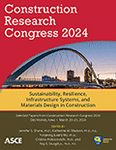Development of an Assessment Tool to Measure the Preparedness of Construction Firms for Upcoming Disasters
Publication: Construction Research Congress 2024
ABSTRACT
Construction firms play an important role in the recovery of communities after a disaster. In order to participate in the recovery of a community, it is important for construction firms to be prepared for disasters well in advance. It is also necessary for the construction firms to have capacity to withstand the disaster first before helping the community. There are several frameworks to assess resilience of communities, but there is a lack of literature and tool to assess the performance of construction firms. This paper aims to fulfill the gap by focusing on the assessment of preparedness of construction firms. A set of previously identified readiness indicators is used to build an assessment tool. This tool consists of a series of questions to be answered by the personnel of construction firms to understand the level of preparedness. The results of this tool are given as a score ranging from 0 to 100 with 0 indicating that the construction firm is not prepared for the upcoming disasters and 100 indicating that the firm is well prepared. The results indicate the strength of the firms and the areas that has scope for improvement.
Get full access to this article
View all available purchase options and get full access to this chapter.
REFERENCES
Alter, K., and Koontz, J. (1996). Curriculum development and continuing education in project management for the specialty subcontracting industry. Journal of Construction Education, 1(2), 66–78.
Assarkhaniki, Z., Rajabifard, A., and Sabri, S. (2020). The conceptualisation of resilience dimensions and comprehensive quantification of the associated indicators: a systematic approach. International Journal of Disaster Risk Reduction, 51, 101840.
Barasa, E., Mbau, R., and Gilson, L. (2018). What is resilience and how can it be nurtured? A systematic review of empirical literature on organizational resilience. International journal of health policy and management, 7(6), 491.
Buckley, J. M. (2010). Exhibition Review: A Spur to Planning:“Agents of Change” at SPUR Urban Center, San Francisco. Journal of Planning History, 9(2), 135–139.
Cutter, S. L., Ash, K. D., and Emrich, C. T. (2014). The geographies of community disaster resilience. Global environmental change, 29, 65–77.
Hartmann, A. (2006). The context of innovation management in construction firms. Construction management and economics, 24(6), 567–578.
Ji, T., Wei, H.-H., Sim, T., Yang, L. E., and Scheffran, J. (2021). Disaggregated validation of disaster-resilience indicators using household survey data: A case study of Hong Kong. Sustainable Cities and Society, 67, 102726.
Kantur, D., and Say, A. I. (2015). Measuring organizational resilience: A scale development. Journal of Business Economics and Finance, 4(3).
Kobayashi, M. (2014). Experience of infrastructure damage caused by the Great East Japan Earthquake and countermeasures against future disasters. IEEE Communications Magazine, 52(3), 23–29.
Lee, A. V., Vargo, J., and Seville, E. (2013). Developing a tool to measure and compare organizations’ resilience. Natural hazards review, 14(1), 29–41.
Renault, B. Y., and Agumba, J. N. (2016). Risk management in the construction industry: A new literature review. Paper presented at the MATEC web of conferences.
Renschler, C. S., Frazier, A., Arendt, L., Cimellaro, G., Reinhorn, A., and Bruneau, M. (2010). Developing the ‘PEOPLES’resilience framework for defining and measuring disaster resilience at the community scale. Paper presented at the Proceedings of the 9th US national and 10th Canadian conference on earthquake engineering.
Sahebjamnia, N., Torabi, S. A., and Mansouri, S. A. (2015). Integrated business continuity and disaster recovery planning: Towards organizational resilience. European Journal of Operational Research, 242(1), 261–273.
Schafer, W. A., Carroll, J. M., Haynes, S. R., and Abrams, S. (2008). Emergency management planning as collaborative community work. Journal of homeland security and emergency management, 5(1).
Sempier, T., Swann, D., Emmer, S., and Schneider, M. (2010). Coastal community resilience index: A community self-assessment.
Serdar, M. Z., Koç, M., and Al-Ghamdi, S. G. (2022). Urban Transportation Networks Resilience: Indicators, Disturbances, and Assessment Methods. Sustainable Cities and Society, 76, 103452.
Winn, G. L., Seaman, B., and Baldwin, J. C. (2004). Fall protection incentives in the construction industry: literature review and field study. International Journal of Occupational Safety and Ergonomics, 10(1), 5–11.
Information & Authors
Information
Published In
History
Published online: Mar 18, 2024
Authors
Metrics & Citations
Metrics
Citations
Download citation
If you have the appropriate software installed, you can download article citation data to the citation manager of your choice. Simply select your manager software from the list below and click Download.
